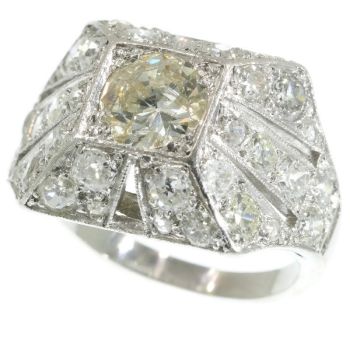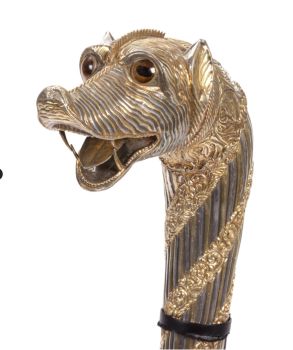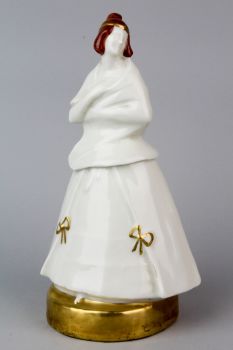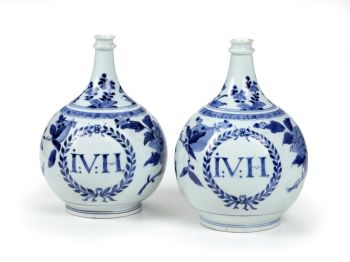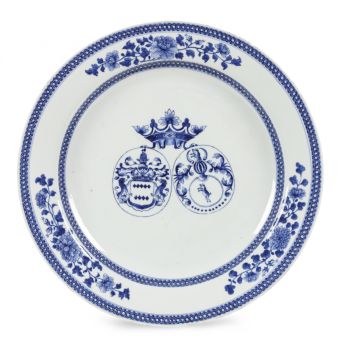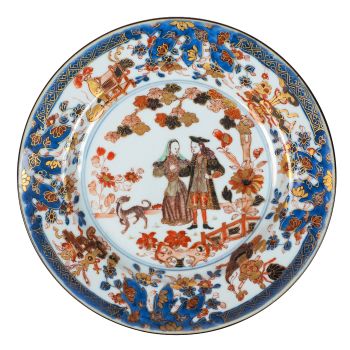Two Chinese porcelain famille rose Mancerina plates, Qianlong Qing dynasty c. 1770 Chinese export di 1770
Unknown artist
PorcelainChinese porcelain
3.50 ⨯ 21.50 ⨯ 21.60 cm
ConditionGood
Price on request
Menken Works of Art
- About the artworkA pair of two famille rose trembleuse stands or chocolate cup holders for the Spanish and Mexican market, ‘mancerina’.
China, Qianlong period, c. 1770.
The mancerina of molded scallop shell form, on raised feet with refined overglaze hand painted famille rose decorations.
These ornate, unusually large saucers with a cupholder in the centre (which are missing in this case) were special pieces made for serving chocolate. It was invented by a Spanish grandee, in Mexico, in the seventeenth century and was named after the man who had invented it, Pedro de Toledo, 1st Marquis of Mancera, who served as Viceroy of Peru from 1639 to 1648.
Called mancerina, the cup holders were designed to catch spilled liquid and help the drinker avoid burning their fingers on a hot cup. The tray could in turn be used to hold pastries. Mancerinas were first made in silver in colonial Mexico and Spain and later copied in ceramics, with models of these pieces sent to Chinese porcelain workshops.
In conclusion, these mancerina are a testament to colonial history and mutual influence between cultures connected via sea trade routes from West to East.
Dimensions (few mm varying in size):
Height 3.5 cm, width 21.5 cm, depth 21.6 cm.
Condition (DM for more pictures):
The first plate with two chips under the rim, the bottom with a star-shaped hairline in the middle (not showing on the top), the raised rim in the center on the top with a small scuff, furthermore in very good condition.
The second plate with a star-shaped hairline in the middle (also showing on the top) and a small hairline to the central border.
Identical mancerina with matching cup can be found in the following museum collections:
-Museo Nacional de Historia, Mexico City, illustrated by M. Priyadarshini, Chinese Porcelain in Colonial Mexico, p. 123, fig. 4.9.
-Carnegie Museum of Art, Pittsburgh, United States, accession no. 70.59.1
-Museum Amparo Puebla de Zaragoza, Mexico
-Museo Nacional del Virreinato, Tepotzotlán, Mexico
-Asian Civilisations Museum, 2022-00043
For a lecture in Spanish by Museo Amparo about this specific mancerina, click on the following link:
https://www.youtube.com/watch?app=desktop&v=T2exETvFg00
Also see:
https://www.youtube.com/watch?v=kJUmINIE1VQ
Inv. No: MW8 - About the artist
It might happen that an artist or maker is unknown.
Some works are not to be determined by whom it is made or it is made by (a group of) craftsmen. Examples are statues from the Ancient Time, furniture, mirroirs, or signatures that are not clear or readible but as well some works are not signed at all.
As well you can find the following description:
•“Attributed to ….” In their opinion probably a work by the artist, at least in part
•“Studio of ….” or “Workshop of” In their opinion a work executed in the studio or workshop of the artist, possibly under his supervision
•“Circle of ….” In their opinion a work of the period of the artist showing his influence, closely associated with the artist but not necessarily his pupil
•“Style of ….” or “Follower of ….” In their opinion a work executed in the artist’s style but not necessarily by a pupil; may be contemporary or nearly contemporary
•“Manner of ….” In their opinion a work in the style of the artist but of a later date
•“After ….” In their opinion a copy (of any date) of a work of the artist
•“Signed…”, “Dated….” or “Inscribed” In their opinion the work has been signed/dated/inscribed by the artist. The addition of a question mark indicates an element of doubt
•"With signature ….”, “With date ….”, “With inscription….” or “Bears signature/date/inscription” in their opinion the signature/ date/ inscription has been added by someone other than the artist
Are you interested in buying this artwork?
Artwork details
Related artworks
Unknown artist
A white jade ‘Lotus Seedpod and Bug’ carving, Qing dynasty, 18th century18th century
Price on requestMenken Works of Art
Unknown artist
An Indian part-gilt silver-clad ceremonial sceptre or mace with a tiger’s head1850 - 1900
Price on requestZebregs & Röell - Fine Art - Antiques
 Curated by
Curated byDanny Bree
1 - 4 / 12Unknown artist
A Japanese bronze Hu flower vase, Edo / Meiji, 19th century19th century
Price on requestMenken Works of Art
HUGO VILFRED VON PEDERSEN
Gadesanger fra Singapore (Musician from Singapore)1870 - 1959
Price on requestZebregs & Röell - Fine Art - Antiques
1 - 4 / 16- 1 - 4 / 24
Unknown artist
Series of 6 Chinese cups and saucers (Yongzheng period)1722 - 1735
Price on requestKuipers Kunst & Antiek
Samuel Dejong
Anatomia Blue Heritage, Atlas Closed2017 - 2019
Price on requestVilla del Arte Galleries
1 - 4 / 24Unknown artist
A white jade ‘Lotus Seedpod and Bug’ carving, Qing dynasty, 18th century18th century
Price on requestMenken Works of Art
1 - 4 / 12






